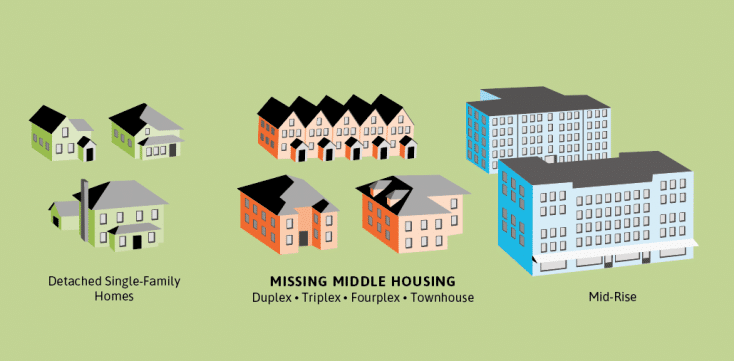Social well-being is a significant component of overall health and well-being. The homes we live in play a substantial role in shaping our mental and social well-being, and the way we design homes can promote—or impede—social connectedness, inclusion and trust between neighbours.[i][ii] To guide the implementation of their Official Community Plan, the Township of Esquimalt is developing a set of policy guidelines for the design of low-rise multi-family (or “missing middle”) housing, with the aim of enhancing the social well-being of those living in these housing types.
A continued partnership
The Township of Esquimalt, located on the southern tip of Vancouver Island and within the territories of the Lekwungen peoples, is home to over 17,600 people—many of whom are young families.[iii] BC Healthy Communities has a history of working with the Township. In 2015, Esquimalt was awarded a PlanH grant to host a Healthy Housing Forum which brought together Township staff and council, community members, health authority representatives and healthy housing experts to generate ideas that would shape the Township’s Healthy Housing Strategy.
Thanks to a PlanH Community Wellness Strategy grant in 2018, the partnership between Esquimalt and PlanH will continue into 2019. Esquimalt planner and project lead Tricia deMacedo is focusing on engaging the community to understand peoples’ current experiences living in multi-family housing, as well as design guidelines to steer the future development of multi-family housing in the community.
Shifting demographics—more young people and young families[iv]—and a growing demand for family-friendly housing have spurred Esquimalt’s renewed prioritization of multi-family housing development. Esquimalt’s relationship with Island Health has also led to a focus on enhancing the social health of those living in multi-family housing. Island Health has been a key player in this project, emphasizing the need for the Township to keep social well-being in mind while developing multi-family and higher density housing forms. Esquimalt’s new guidelines will focus on making multi-family dwellings and neighbourhoods safe, affordable, inclusive and practical while keeping social well-being top-of-mind.
What is ’missing middle’ housing?
Low-rise multi-family housing, often referred to as “missing middle” housing, is a range of multi-unit or clustered housing types that are compatible in scale with single-family homes.[v] These housing types include duplexes, four-plexes and bungalow courts. Missing middle housing offers up a solution to the mismatch between available housing stock, shifting demographics and a growing demand for walkability and active transportation in urban neighbourhoods.
This kind of housing supports the growing demand for walkable urban neighbourhoods, which include locally-serving retail and public transport options. Through intentional design, this type of housing can also promote mental and social well-being. For example, design features such as shared gardens, common areas (such as recreation rooms, rooftop decks and communal kitchen spaces) and on-site local shops and services can enhance social connectedness and social well-being.[vi]
From policy to action
The Township of Esquimalt is embarking on this engagement and policy development process to guide the implementation of policy objectives outlined in their Official Community Plan. The Township will work with a consultant, a Healthy Built Environment specialist from Island Health, and staff from BC Healthy Communities to design, execute and facilitate a community engagement process, gathering input on design guides for multi-family housing.
“Encourage the incorporation of spaces designed to foster social interaction.”[vii]
–Policy Statement, Township of Esquimalt Official Community Plan
To ensure broad community engagement, the Township will use a variety of engagement methods to reach as many residents as possible, including pop-ups at frequented community spaces such as the farmers market, recreation centre and local parks, as well as a community-wide survey and a housing forum that will bring together staff, councillors, experts and stakeholders and community members. The information gathered will shape a final report with recommendations to Esquimalt Council on policy recommendations and design guidelines to enhance social well-being. Esquimalt Mayor Barb Desjardins says the process also will benefit from the Township’s longstanding commitment to public consultation, ensuring the policy guidelines align with other municipal strategies and planning documents.
“The information gathered through this process will complement previous municipal community consultation initiatives including our Official Community Plan and Age-Friendly Assessment,” says Mayor Desjardins. “Our goal is to create safe, affordable and inclusive housing for all ages that contributes to social health and well-being.” The Township received Age-friendly Community recognition in 2012.
Lasting impact
The legacy of this project will go beyond a final report, influencing policy and guiding the development of multi-family housing and neighbourhoods for years to come. Through the community engagement process, the Township hopes to strengthen community networks and connections. Of course, the greatest legacy of this project will be felt by the future residents of new multi-family housing developments in the community, who will live in environments conducive to positive social health and well-being.
For more information on how multi-family housing supports health and well-being, explore the resources linked below.
· Happy City – Happy Homes: A toolkit for building sociability through multi-family housing design
· Provincial Health Services Authority – Healthy Built Environment Linkages Toolkit: Making the links between design, planning and health(see section on Healthy Housing)
· PlanH – Healthy Housing
[ii] BC Centre for Disease Control. (2018). Healthy Built Environment Linkages Toolkit: making the links between design, planning and health, Version 2.0. Vancouver, B.C. Provincial Health Services Authority.
[iii] Statistics Canada. (2016). Esquimalt Census Profile.
[iv] Statistics Canada. (2011). Esquimalt Census Profile., in contrast to Statistics Canada. (2016). Esquimalt Census Profile.
[v] Missing Middle Housing. (nd.). About.
[vi] Happy City. (nd.). Happy Homes: A toolkit for building sociability through multi-family housing design.
[vii] Township of Esquimalt. (2018). Official Community Plan. P.28




